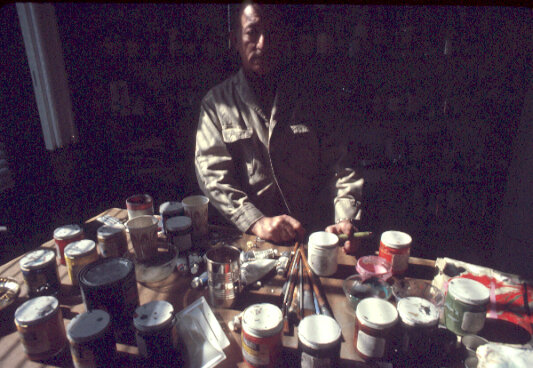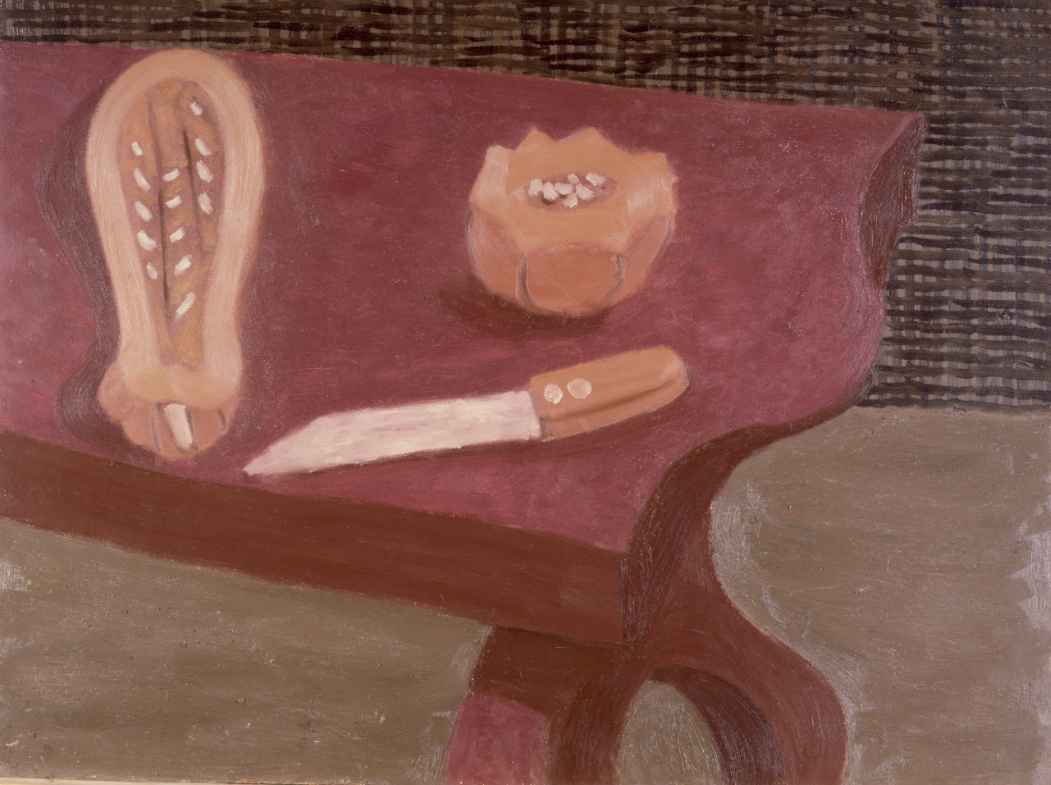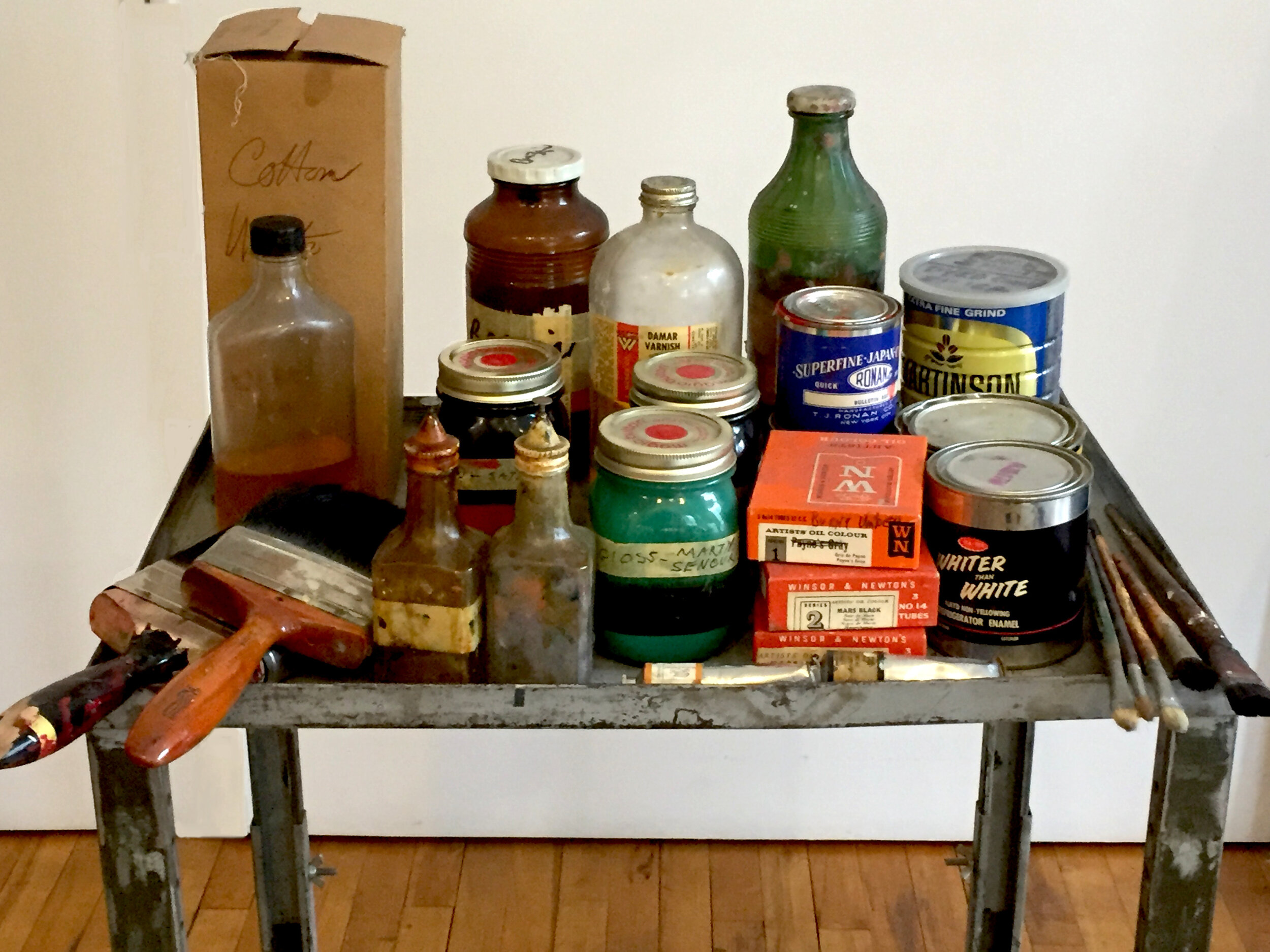Adolph Gottlieb in Provincetown, 1952. Photographer: Maurice Berezov.
Adolph Gottlieb in his studio, 1960. Photogapher: Guy Weill
"The painter Joseph Solman once told me that he and Adolph Gottlieb were at a Picasso show in the 1930s when Adolph suddenly said, 'I get it--it's physical.'
Gottlieb recognized painting was language and that language shapes meaning through the studied use of details. In the art of painting, materials are a large part of detail so the precise meaning an artist intends relies on the artists' materials as much as anything else."
– Sanford Hirsch, Executive Director of the Gottlieb Foundation
Adolph Gottlieb in his studio painting Ascent (1958), 1958. Photographer: Rudolph Burckhardt.
In a 1965 interview with Gladys Kashdin, Gottlieb once said, "Well, I've tried every possible thing -- sure I've used rollers, I've used squeegees, I've used rags and knives and sticks -- I think that in order to express what you want to express you have to find your own way of doing it, the right materials and tools and so on You don't have to, but it's preferable, to find something that fits what you are trying to express."
Adolph Gottlieb at his Bowery Studio with paints and brushes, 1968. Photographer: Michael Fredericks.
Adolph Gottlieb began using commercial house paints and other nontraditional materials when he and Esther lived in Tucson, Arizona in 1938. In a 1967 Interview with Dorothy Seckler, Gottlieb said of working in Arizona, " I produced a great deal of work during this period I was away from the New York scene and started using the material that was at hand. I didn't have any money. Art supplies were expensive. I started using paint from cans that I got from paint stores. I painted the objects that I picked up from the desert, dry pieces of cactus and other things, pieces of bone."
Untitled (Arizona Still Life), 1938, oil on pressed board, 36 x 47 15/16 “
One important aspect of Gottlieb's Pictographs, painted between 1941 and 1954, is the artist's use of various materials in order to obtain very specific surface and density effects. In these paintings, Gottlieb used oil paints, gouache, casein, enamels and other materials like smalts and cotton waste to paint discrete areas in order to amplify the emotional impact of each painting.
Alkahest Of Paracelsus, 1945, oil and egg tempera on linen, 60 x 44 ". Currently in the collection of the Museum of Fine Arts, Boston
The Token, 1945, oil, tempera & casein on canvas, 31 7/8 x 24 7/8 " Currently in the collection of the Cantor Center at Stanford University.
Gottlieb continued to use commercial paints and other manufactured materials along with traditional artist materials throughout his career. His objective was to obtain precise optical and sensual effects to give added emotional meaning to his art.
Labyrinth #3, 1954, oil and enamel on canvas, 80 x 185”. Currently in the collection of Institut Valencià d'Art Modern, Spain.
Adolph Gottlieb at his Bowery Studio with materials, 1968. Photographer: Michael Fredericks.
Adolph and Esther Gottlieb in the East Hampton studio with Roman III #3 and Burst 1973 (both 1973), summer 1973.
"I think that the important thing about this accidental effect and the use of the accident is that, for one thing, it allows a certain spontaneity, and it gets away from the tradition of brush and a buttery kind of paint application. You have to remember that the tools and materials that we've inherited were highly perfected over the last few hundred years, mainly for the purpose of painting portraits or landscapes; and if you want to do some other kind of painting, you have to find other tools, perhaps, or other material; or change the nature of the material so that it's suitable to what we want to express, rather than the painting of portraits."
– Adolph Gottlieb in an interview with Martin Friedman, August 1962
Adolph Gottlieb's painting materials from his studio.
All Artworks ©Adolph and Esther Gottlieb Foundation/Licensed by ARS, NY, NY
To see more artwork by Adolph Gottlieb, visit our website.











